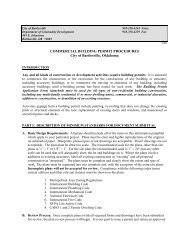Streets - City of Bartlesville
Streets - City of Bartlesville
Streets - City of Bartlesville
Create successful ePaper yourself
Turn your PDF publications into a flip-book with our unique Google optimized e-Paper software.
R&R - is an abbreviation for remove and replace – deep patching. The R&R designation is used<br />
to identify rehabilitation strategies that have additional funds set aside for increased amount <strong>of</strong><br />
surface preparation.<br />
Olay - is an abbreviation for overlay.<br />
Rehab Costs – the rehabilitation costs are presented on a per square yard basis for each<br />
pavement type–functional class–rehabilitation activity combination. The rates were developed<br />
using typical national averages for similar activities and then were adjusted for <strong>Bartlesville</strong>’s<br />
location and unique conditions. The rates do not include any burdens or allowances to cover<br />
costs for traffic control and site preparation, striping and pavement markings, engineering and<br />
inspection, ADA compliance, landscaping, signals or signage upgrades, peripheral concrete<br />
repairs and miscellaneous costs or contingency. Typically these burdens, in addition to <strong>City</strong><br />
overhead costs, can add 25 to 35% to the unit rates and overall budgets.<br />
PCI Range - defines the Pavement Condition Index (PCI) range applicable to the rehab selection.<br />
Segments that fall between the Minimum PCI and Breakpoint PCI are funded first in the defined<br />
Rehabilitation Order. Once these are selected, the s<strong>of</strong>tware recycles through the segments<br />
selecting non-critical streets in order <strong>of</strong> priority up to the maximum PCI value.<br />
The Minimum PCI value is the lower limit which rehabilitation may be applied, beyond that value,<br />
a heavier rehabilitation is required. The Breakpoint PCI defines the range that if a segment is<br />
deferred, it will drop below the Minimum PCI within one year and thus require a thicker<br />
rehabilitation. The maximum PCI is the condition score where the lighter rehabilitations may be<br />
applied. The combination <strong>of</strong> these three values establishes a methodology <strong>of</strong> optimizing<br />
available funding by always selecting critical segments in their need year, and allowing others to<br />
be deferred until they become critical.<br />
Constraint – defines the Load Associated Deducts (LAD) range applicable to the rehab<br />
selection. The LAD identifies streets with potential structural issues that either require a thicker<br />
rehabilitation or increased level <strong>of</strong> patching and preparation work. Conversely, segments with low<br />
LAD may receive lighter treatments.<br />
Post Rehab Resets Values – Defines key condition values to be applied once the street<br />
segment has been rehabilitated.<br />
Order – defines the order in which rehabilitations are applied. Once combined with the segment<br />
priority, these two factors determine the order in which streets are selected for rehabilitation. The<br />
Priority lists the segments from highest to lowest priority, while the Order defines which<br />
rehabilitations are funded first.<br />
The Rehabilitation Order is based on the incremental cost <strong>of</strong> deferral – that is, the lower the<br />
Rehabilitation Order, the greater the cost if the rehabilitation is deferred.<br />
IMS Infrastructure Management Services <strong>Bartlesville</strong> 2012 Report Rev1 page 15








